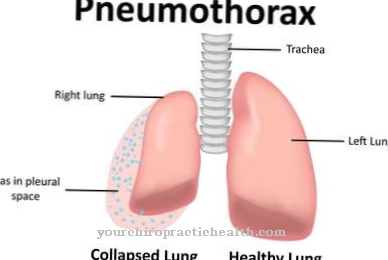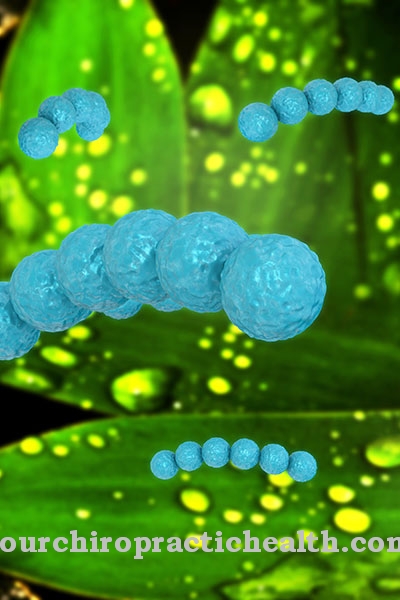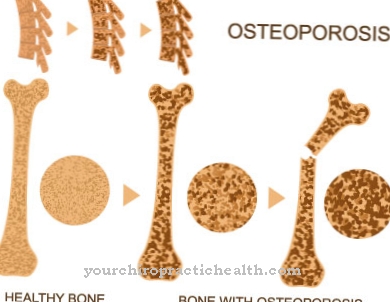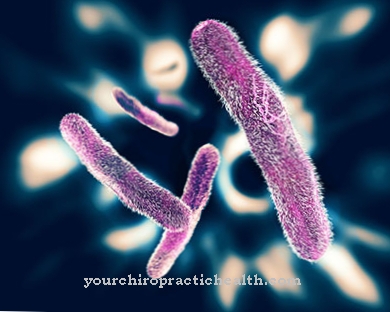Alexander disease is a very rare, fatal condition that destroys white matter in the brain and spinal cord. She is also under the name Alexander Syndrome, Alexander disease and dysmyelinogenic leukodystrophy known.
What is Alexander's disease?

© Henrie - stock.adobe.com
The pathologist William Stewart Alexander described Alexander disease first time as a disease. It is one of the leukodystrophy diseases. These are genetic metabolic diseases in which the white matter of the nervous system degenerates. Alexander syndrome affects the white matter in the brain and spinal cord.
Alexander's disease differs from the other leukodystrophy diseases in that special tissue cells in the nervous system, the astrocytes, are infected with Rosenthal fibers. The Rosenthal fibers are worm-shaped inclusions in the cell. The disease is divided into four forms, which depend on the age of those affected. The infantile form is the most common. It occurs in young children. There is also the neonatal form in newborns, the juvenile form in adolescents and the adult form in adults.
Sometimes scientists use the term Alexander's disease only for the infantile form. Boys suffer from the infantile form more often than girls. The rarity of this disease is shown by the fact that doctors estimate the number of scientifically examined patients worldwide to be around 150. In 2011 there were only 50 proven cases in Germany.
causes
The disease is due to a genetic mutation. The gene for the production of the GFAP protein is affected by this mutation. It usually occurs spontaneously, which means that children of healthy parents are also susceptible to this disease. Research has shown that the mutation appears to originate predominantly from the father's genes. How this change in the gene leads to the degeneration of the nerve cells and the typical changes in the brain has not yet been clarified.
Symptoms, ailments & signs
The disease manifests itself differently depending on age. In the infantile form, there are clear developmental disorders in motor and sensory functions. There are also disorders of movement coordination. In addition to the enlargement of the skull, another symptom is the enlargement of the brain. Those affected have difficulty swallowing and suffer from spasticity, i.e. the contraction of individual muscles or muscle groups and seizures.
In the neonatal form, the same symptoms appear and become worse in a much shorter period of time. The symptoms of the juvenile form are case-dependent. Not all signs of the disease appear. Sometimes adolescent patients do not have seizures and do not suffer from spasticity. The enlargement of the skull, known as macrocephalus, also occurs less often in juvenile patients.
The typical symptoms of Alexander's disease occur in the adult form much less often and in a milder form. However, doctors have found that in adults, the brainstem is more affected by the destruction. There are speech disorders and involuntary twitching of the uvula.
Diagnosis & course of disease
Alexander's disease is a fatal disease. It leads to severe disability and ends in cardiovascular failure. After the disease was discovered, it was initially customary to make a diagnosis through a biopsy, the removal of a tissue sample. Magnetic resonance imaging of the brain is now being performed to check the diagnosis of a juvenile form.
In order to be sure of the diagnosis, doctors use four criteria when evaluating the brain scan:
- The first criterion is a change in the central white matter in the brain.
- Another confirmation is the presence of a periventricular seam. In certain areas of the brain, depending on the type of exposure of the scan, darker or lighter zones are shown that do not have this color gradation during normal development.
- The enrichment of certain brain regions with contrast media is also an indication of the disease.
- The fourth criterion is anatomical abnormalities in the area of the thalamus, the brain stem and the basal ganglia, which are located below the cerebral cortex. In adults, recognizable tissue atrophy and signal changes in the brain stem and spinal cord are additional indications.
Complications
Alexander's disease causes very serious complaints and complications in everyday life for the patient. As a rule, various motor disorders occur, so that deforestation of the child is significantly limited. The coordination and movement of the patient is also restricted by Alexander's disease, so that the patients are also dependent on the help of other people in their everyday lives.
Furthermore, there are discomforts when swallowing and spasticity develops. The difficulty swallowing can also make it difficult to take food or fluids. It is not uncommon for the parents of those affected to be severely affected by Alexander's disease and suffer from psychological complaints or depression. As the disease progresses, language disorders occur, which can also lead to bullying or teasing children.
The patient's quality of life is severely restricted by Alexander's disease. The life expectancy of the affected person is also reduced by the disease, so that the affected person eventually dies due to heart failure. Treating the disease can only alleviate the symptoms, but not completely resolve them. Furthermore, the relatives or parents often need psychological treatment in order to cope with the psychological stress.
When should you go to the doctor?
If developmental disorders are noticed in various areas in an adolescent child, a doctor should always be consulted. In the case of physical or mental abnormalities, it is advisable to carry out a medical examination so that the symptoms can be clarified. Disturbances and irregularities of the movement sequences, the motor function as a whole and the sensorimotor function must be examined and treated.
If, in direct comparison with children of the same age, there are behavioral problems and inconsistencies in locomotion, medical help is required. Since Alexander's disease is fatal, a doctor should be seen at the first signs and suspicion of a possible health problem.
With an individual treatment and therapy plan, existing symptoms can be medically treated and the quality of life of the sick person can be significantly improved. In the case of speech disorders, cramps, a seizure disorder or spasticity, a doctor's visit is necessary. If there are abnormalities in the muscular system, contractions of individual muscle fibers or if an enlarged head shape is perceived, a doctor should be consulted.
An optical peculiarity of the skeletal system is often a sign of a health disorder. It should be discussed with a doctor immediately. Disorders of the voluntary movement are further indications for an existing disease. In particular, an irregularity of the uvula indicates Alexander's disease and should be presented to a doctor.
Therapy & Treatment
The different forms are of different length and weight. Sick infants die after a few months. Adults, children and adolescents can live with this disease for years. The infantile form shows the first symptoms between the ages of six months and one year. Contrary to the infantile form, the others appear equally in boys and girls. The juvenile variant begins in the first or second decade of life. The adult form breaks out between the ages of 20 and 45.
There is no cure and therapy is not possible. The treatment only tries to alleviate or treat the symptoms of Alexander's disease. It is done with antiepileptic drugs, antispastics or antispasmodic and pain reliever drugs. Difficulties in eating food due to the difficulty swallowing associated with the disease require the insertion of a gastric tube in some patients.
Further measures are physiotherapy, occupational therapy and speech therapy. Physiotherapy relieves cramping of the limbs. In any case, not only is the patient receiving treatment, but also the affected family members need supportive advice.
Outlook & forecast
The prognosis for Alexander's disease is generally poor. According to the current state of research, a cure is excluded. Affected children usually die within the first ten years of life. The specific prognosis of the sick person depends mainly on the form and the age of the disease.
After the outbreak of Alexander's disease, severe multiple disabilities occur within a few months to years, leading to death from cardiovascular failure. The disease progresses fastest in the neonatal form. The affected children usually die in infancy. The juvenile form of Alexander's disease is somewhat milder. Neurological deficits only appear much later. Symptoms such as seizures and spasticity also occur much later or not at all with this form. In the long term, the disease leads to the death of the patient even with this form of course.
No specific statements can be made about the prognosis of the adult form of Alexander's disease. As a rule, it is much milder than the forms of the disease in childhood. There are often long-lasting courses with initially only minor impairments such as swallowing and speech disorders.
prevention
Since a mostly spontaneous mutation is responsible for Alexander's disease, there are no preventive measures. According to scientific assumptions, the probability that parents of affected children will have another child with this mutation is one percent. However, if the disease occurs in the family, doctors recommend genetic counseling and prenatal diagnosis.
Aftercare
Alexander's disease is an incurable disease that is usually fatal. Follow-up care focuses on caring for the remaining family members after the child dies. The doctor establishes contact with a suitable therapist and a self-help group. It is important to process the grief in order to regain quality of life. Understanding the disease is also important here.
In addition, general measures such as exercise and rest will help to deal with the trauma. Which of these are useful for the individual in detail must be discussed with the responsible doctor. Aftercare in the true sense of the word does not exist for Alexander's disease. If the parents decide to have another child, a genetic test can be performed.
The genetic test is used to estimate the risk of illness in the second child. As part of the subsequent consultation, the options are discussed with the parents. If there is a high risk of illness, a new pregnancy is not advisable. If the risk is low, the parents-to-be must also be looked after closely.
You can do that yourself
Alexander's disease is a serious disease that cannot be treated causally. The parents of affected children should seek therapeutic support at an early stage. In a self-help group for affected parents, the relatives learn to deal with the disease and to deal with the mostly negative course.
An important accompanying measure is a physiotherapy treatment that can be continued by the parents at home. Physiotherapy and occupational therapy cannot solve the symptoms, but they can slow down the course of the disease. In addition, physical exercise and support increase the child's quality of life. Close monitoring by the doctor is just as important. Parents should also pay close attention to any unusual symptoms and, if in doubt, call emergency medical services. Depending on the type and severity of Alexander's disease, appointments with a speech therapist and other specialists must be organized and the necessary aids purchased.
People suffering from the adult form of Alexander's disease should also see a psychologist. In the beginning, exercise and dietary measures can slow the progression of the disease. Genetic counseling is recommended if the disease occurs in the family.


.jpg)
























